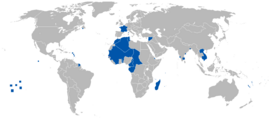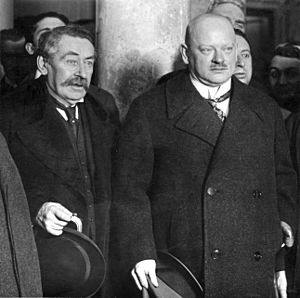Aristide Briand facts for kids
Quick facts for kids
Aristide Briand
|
|
|---|---|

Briand c. 1920s
|
|
| Prime Minister of France | |
| In office 29 July 1929 – 22 October 1929 |
|
| President | Gaston Doumergue |
| Preceded by | Raymond Poincaré |
| Succeeded by | André Tardieu |
| In office 28 November 1925 – 17 July 1926 |
|
| President | Gaston Doumergue |
| Preceded by | Paul Painlevé |
| Succeeded by | Édouard Herriot |
| In office 16 January 1921 – 12 January 1922 |
|
| President | Alexandre Millerand |
| Preceded by | Georges Leygues |
| Succeeded by | Raymond Poincaré |
| In office 29 October 1915 – 17 March 1917 |
|
| President | Raymond Poincaré |
| Preceded by | René Viviani |
| Succeeded by | Alexandre Ribot |
| In office 21 January 1913 – 18 March 1913 |
|
| President | Armand Fallières |
| Preceded by | Raymond Poincaré |
| Succeeded by | Louis Barthou |
| In office 24 July 1909 – 27 February 1911 |
|
| President | Armand Fallières |
| Preceded by | Georges Clemenceau |
| Succeeded by | Ernest Monis |
| Minister of Foreign Affairs | |
| In office 23 July 1926 – 12 January 1932 |
|
| Prime Minister | Raymond Poincaré André Tardieu Camille Chautemps Théodore Steeg Pierre Laval |
| Preceded by | Édouard Herriot |
| Succeeded by | Pierre Laval |
| Minister of Justice | |
| In office 24 August 1914 – 29 October 1915 |
|
| Prime Minister | René Viviani |
| Preceded by | Jean-Baptiste Bienvenu-Martin |
| Succeeded by | René Viviani |
| In office 14 January 1912 – 21 January 1913 |
|
| Prime Minister | Raymond Poincaré |
| Preceded by | Jean Cruppi |
| Succeeded by | Louis Barthou |
| In office 4 July 1908 – 24 July 1908 |
|
| Prime Minister | Georges Clemenceau |
| Preceded by | Edmond Guyot-Dessaigne |
| Succeeded by | Louis Barthou |
| Member of the Chamber of Deputies | |
| In office 27 April 1902 – 7 March 1932 |
|
| Constituency | Loire (1902–09) Loire-Inférieure (1909–32) |
| Personal details | |
| Born |
Aristide Pierre Henri Briand
28 March 1862 Nantes, Loire-Atlantique, French Empire |
| Died | 7 March 1932 (aged 69) Paris, France |
| Political party | French Socialist Party (1902–1904) Independent Socialists (1904–1911) Republican-Socialist Party (1911–1932) |
| Education | University of Paris |
Aristide Pierre Henri Briand (born March 28, 1862 – died March 7, 1932) was a very important French leader. He served as Prime Minister of France eleven times during a period known as the French Third Republic. He is mostly remembered for his efforts to promote peace and cooperation between countries, especially during the time between World War I and World War II.
In 1926, he won the Nobel Peace Prize along with German Foreign Minister Gustav Stresemann. They received it for their work on the Locarno Treaties, which aimed to bring France and Germany closer after the First World War. To prevent another big war, Briand also helped create the Kellogg–Briand Pact in 1928. He even suggested forming a "European Union" in 1929. However, his peace efforts faced challenges from rising nationalistic ideas like Nazism and fascism after the Great Depression.
Contents
Early Life and Education
Aristide Briand was born in Nantes, France, into a middle-class family. He went to the Nantes Lycée. There, in 1877, he became good friends with the famous writer Jules Verne. Briand later studied law at the University of Paris. Soon after, he became involved in politics. He wrote for different newspapers and became known for his progressive ideas.
Political Beginnings and Reforms
Briand was very active in the movement to form trade unions, which are groups that protect workers' rights. At a workers' meeting in Nantes in 1894, he helped get the idea of labor unions accepted. After this, Briand became a leader in the French Socialist Party. In 1902, he was elected as a deputy, which is like a member of parliament. He strongly supported different left-wing groups working together to stop conservative politicians.
One of Briand's main focuses was the separation of church and state in France. He played a key role in creating the 1905 law that officially separated the government from the church. He made sure this important law was passed with only small changes. He also worked to put the law into practice.
Briand believed that Socialists should work with other reform-minded parties to achieve progress, instead of waiting for all their ideals to be met. He joined a government ministry in 1906, which led to him being removed from the Unified Socialist Party.
Aristide Briand as Prime Minister
Before World War I
Briand served as Minister of Justice before becoming Prime Minister for the first time on July 24, 1909. He held this position until March 2, 1911. During this time, his government passed an important law in April 1910 that created pensions for workers and farmers. This meant that people would get money when they retired. Also, health and old-age insurance became required for many workers.
He served as Minister of Justice again from 1912 to 1913. Then, he became Prime Minister for a few months in early 1913.
During World War I
When World War I began in August 1914, Briand became Minister of Justice again. In October 1915, he became Prime Minister for a second time. He also took on the role of Foreign Minister, which meant he was in charge of France's relationships with other countries. He promised to work closely with France's allies, especially Britain.
Briand worked to improve cooperation between the French military and the government. He also pushed for closer ties with other Allied nations. He got along well with British Prime Minister Lloyd George. They often discussed war strategies.
In December 1916, Briand formed a new, smaller government to make decisions more quickly. He appointed General Lyautey as the new War Minister. Briand resigned as Prime Minister on March 20, 1917, due to disagreements over a planned military attack.
After World War I: The 1920s

Briand returned to power in 1921. He helped lead France's role in the Washington Naval Conference (1921–22). This meeting aimed to limit the size of navies around the world. France needed to protect its colonies and trade routes, especially in the Mediterranean Sea. The conference set limits on large warships for major countries. France's participation showed that it needed to manage its power and resources carefully after the war.
Briand tried to reach an agreement with Germany about war reparations (payments for damages). However, these talks failed. After a crisis where France occupied the Ruhr region of Germany, Briand's more peaceful approach became popular again. He became Foreign Minister in 1925 and stayed in that role until his death in 1932. During this time, he was part of 14 different governments, leading four of them himself.
Kellogg–Briand Pact
As mentioned, Aristide Briand won the 1926 Nobel Peace Prize with Gustav Stresemann of Germany. This was for their work on the Locarno Treaties, which helped bring peace between France and Germany.
In 1927, Briand and United States Secretary of State Frank B. Kellogg suggested a worldwide agreement to outlaw war. This idea led to the Kellogg–Briand Pact in 1928, also known as the Pact of Paris. Many countries signed this pact, agreeing not to use war to solve their problems.
Briand's Plan for European Unity
As Foreign Minister, Briand developed an interesting idea for a new economic union in Europe. He proposed this idea in a speech at the League of Nations on September 5, 1929. He later wrote a detailed plan called the "Memorandum on the Organization of a Regime of European Federal Union" in 1930.
His idea was to create a framework for European countries to work together, especially to manage Germany's growing economic power after the war. He wanted economic cooperation, but his main goal was political security. The plan aimed to protect Eastern Europe from threats and encourage industrial collaboration across Europe.
However, Briand's plan was never fully adopted. This was partly because his main supporter, German Foreign Minister Gustav Stresemann, died. Also, the Great Depression began in 1929, causing economic problems worldwide. Even though his plan wasn't put into action then, it suggested an economic framework that later helped inspire the creation of the European Union after World War II.
Images for kids
See Also
 In Spanish: Aristide Briand para niños
In Spanish: Aristide Briand para niños
- Interwar France
- List of people on the cover of Time magazine: 1920s






